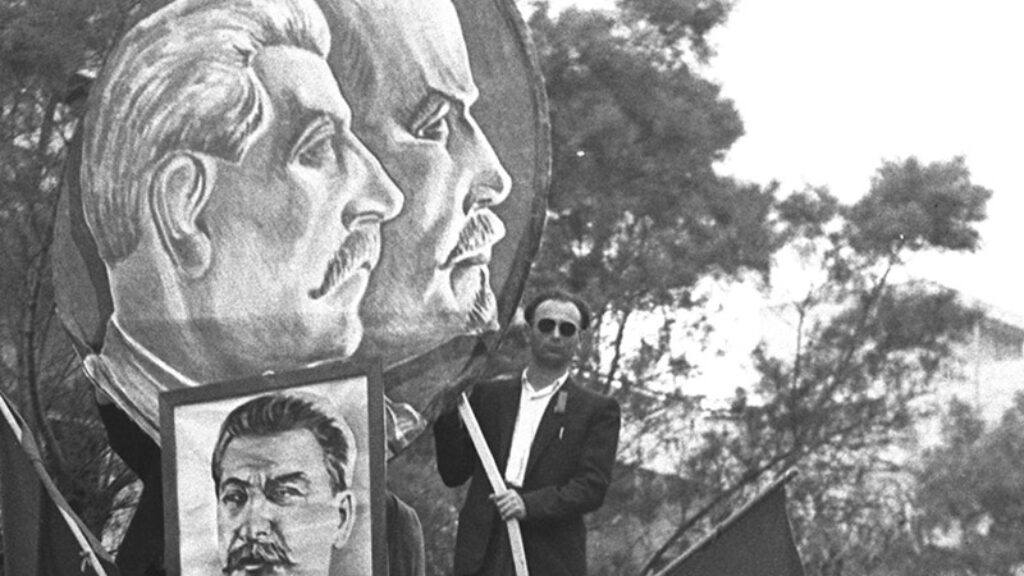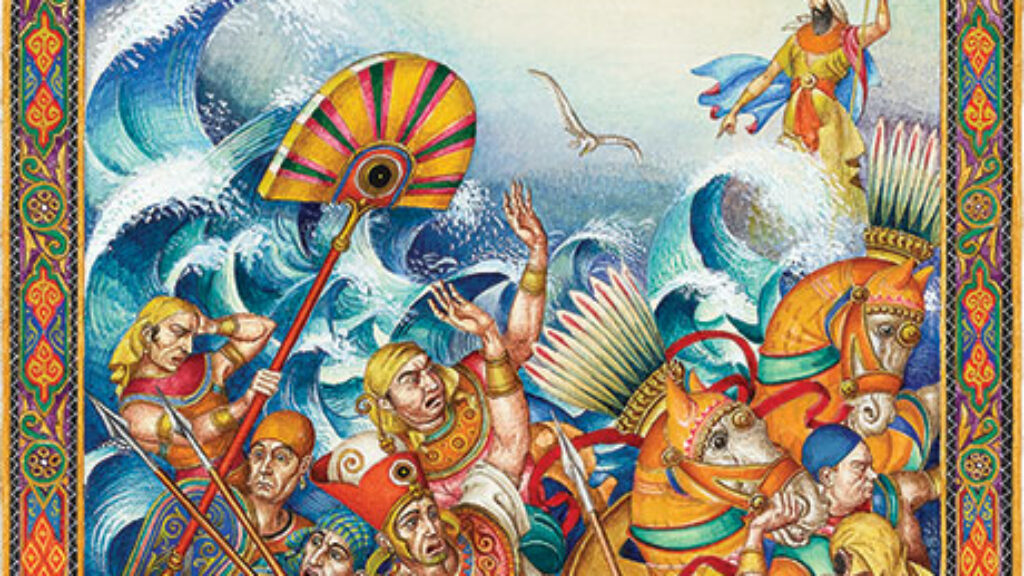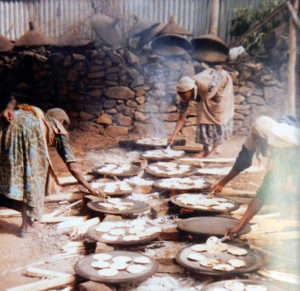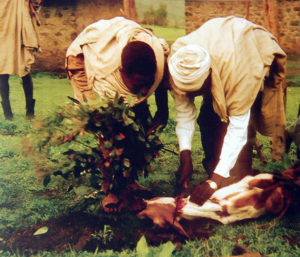Searching for Ancient Passover in Samaria and Ethiopia
I spent the winter of 2013 in the National Library of Israel reading ancient texts about the Temple sacrifices at Passover, which had been conducted only a few miles away. Like so many people immersed in historical research, I wished I could go back in time to witness these events for myself. Instead, I read from the Mishnah:
They bring the first group [into the Temple to offer their lambs], and they fill up the courtyard, and they lock the doors to the courtyard. They blow [the shofar] tekia, teru’a, tekia. The priests stand in two lines . . . one line holds bowls of silver, one line holds bowls of gold—they do not mix . . . An Israelite slaughters and a priest receives the blood, and he gives it to his colleague, and he passes it to his colleague, and to his colleague who receives it full and returns it empty. The priest nearest to the altar dashes it, in one toss, on the base [of the altar]. The first group goes out and the second group comes in. The second group goes out and the third group comes in.
Reading this text, I can imagine roiling crowds of sweaty pilgrims approaching the 37-acre Temple plaza, waiting to bring their animals inside for slaughter. For Passover, the Temple stones were washed to a bright white, but by this time the floor was likely soaked in blood. I can imagine the sounds of anxious animals bleating and Levites chanting. Inside, a priestly bucket brigade conveyed the animals’ blood to a huge, smoky altar giving off a pungent odor that dominated the whole city. Later that evening, the people took the slain animals back to their encampments to roast them.
I couldn’t jump in a time machine and watch Jews offer paschal sacrifices two thousand years ago, but I could do the next best thing: Visit the Samaritans. The Samaritans claim descent from some of the lost northern tribes of Israel; they split from the Judeans (who later became “Jews”) more than two millennia ago. The Samaritan Bible is substantially similar to the Jewish Torah, but the Samaritans have no prophetic books, no psalms, no Mishnah, no Talmud. Samaritan traditions are completely unmediated by late biblical or rabbinic influence, which is why they have Passover but no Seder.
The Samaritans welcome visitors to their Passover ritual. In fact, they erect bleachers for the tourists. I thought—hoped, really—that observing their Passover might feel like going back in time, but it didn’t. I’m pretty sure the ancient Israelites didn’t wear white plastic jumpsuits or wash away rivers of blood with garden hoses.
Exodus 12 prescribes that the paschal lambs be slaughtered at sundown on the 14th of Nisan. Since the Samaritan calendar differs from the rabbinic calendar, for us rabbinic Jews it was only an ordinary Tuesday. Some friends and I boarded a bus from Jerusalem to a small town in the West Bank, called Kiryat Luza, where about half the world’s population of Samaritans live—about four hundred people.
The Samaritans dressed all in white: white jeans, white T-shirts, white sneakers—I even saw someone in a white bathrobe. Most people covered their heads with white baseball caps, though the elders were distinguishable by their red fezzes and belted white robes. Deep fire pits and sharp spits had been prepared to roast the victims, which were conveyed to their demise in shopping carts.
As the sun sank to the horizon, the elders began to chant. Their language has its own guttural sound, different from ancient or contemporary Hebrew and not exactly like Arabic either, but still unmistakably Semitic. The names of our common biblical ancestors, Abraham, Isaac, and Jacob, were easily discernable. At exactly sundown, the chanting stopped, and the sheep were simultaneously slaughtered with a swift and singular motion that, to my surprise, made no noise. And then there was sound again—a flurry of activity as the animals were rapidly skinned, gutted, stuffed with salt, and spitted.
In deference to the request of the community, we left before the lambs were roasted and eaten—that part of the ceremony is just for community members. I packed up my camera with the sandwich I had thoughtlessly brought along and then kept shamefully hidden at the bottom of my backpack (like us, the Samaritans eat only unleavened bread on Passover), and headed back to Jerusalem. At the time, I imagined that I had just witnessed the only paschal offering made in modern times.
I was wrong. It turns out that, like the Samaritans, the Jews of Ethiopia also have a biblical Passover, though those who have come to Israel have largely assimilated to the rabbinic Seder. The fascinating Koren Ethiopian Haggada: The Journey to Freedom, which pairs a traditional Seder text with documents that celebrate the Ethiopian Passover tradition and the Ethiopian aliyah to Israel, outlines some of the community’s Passover traditions as they were performed before the Ethiopians came into contact with other Jews. Of course, the idea of documenting these nonrabbinic traditions in a rabbinic haggadah carries its own irony. But as a vehicle for preservation, a haggadah is a proven choice.
Before coming into contact with the rest of world Jewry, the Ethiopian Jews would prepare for Passover by purging their homes of leaven, which included not only leavened grains but also leavened milk like yogurt and cheese as well as leavened beverages. They carefully selected suitable lambs and goats without blemish (also preferably of one solid color) and observed a fast of the firstborn. When the 14th of Nisan arrived, they positioned their lambs with the lambs’ faces toward the rising sun—the direction of Jerusalem—for slaughter. Most of the blood poured into the ground and was covered over, but leafy branches were employed to catch any blood that spattered upward. This blood was daubed on the doorway to the synagogue.
Ethiopian Jews ate their lambs with matza cooked over a fire and bitter herbs (usually shiny-leaf buckthorn, a plant called “gesho”), and with their loins girded—just as their ancestors in Egypt had done. As they ate, their priests and elders recounted the story of the Exodus, and the men held an all-night vigil, reciting prayers thanking God for redemption. For example, this short prayer entitled “Nisan Halleluya,” apparently drawing on Exodus 12:1–2:
Halleluya, Nisan, Nisan, Halleluya
And the Lord said to Moses:
Go tell the children of Israel
And say to the House of Jacob:
In the first month, that very month
I did redeem you from the land of Egypt.
It shall be the first month of the year
And His name shall be blessed on the first day of the new month.
It is impossible to say if the Passover rituals described in the Koren Ethiopian Haggada are an accurate reflection of ancient Passover practice, so I don’t know if this is really my time machine. But they do hew closely to the biblical text. For instance, Jews today omit only leavened grains from our diet on Passover, but traditional Ethiopian Jews purged all leavened foods, which might demonstrate a better understanding of the original meaning of the word “chametz.” And it has always struck me as interesting that there is no record (known to me) of rabbinic Jews smearing the blood of their Passover sacrifice on their doorposts, though this seems an obvious ritual to develop from the text. But the Ethiopian Jews did it. And in some ways, reciting the story of the Exodus directly makes a lot more sense than reading aloud the complicated and sometimes confusing rabbinic midrash that is the core of a contemporary Seder.
Today, there are some eight thousand Falash Mura residing in Gondar and Addis Ababa, mostly people of Jewish descent whose ancestors converted to Christianity. They are waiting for the Israeli government to allow them to make their own Exodus. The Jerusalem Post recently reported that Israel has delayed permission, and they are in the midst of preparations for another Passover in Ethiopia.
Suggested Reading

Frenemies, A Love Story
A new look at the most unlikely alliance that brought the Jewish State into being.

Smitten with Sympathy
As the sea split, God shushed the angels, saying, “My handiwork is drowning in the sea and you are reciting songs before me?”
Arendt, Banality, and Benhabib: A Final Rejoinder
Richard Wolin pens a final rejoinder in his debate with Seyla Benhabib regarding Hannah Arendt and Adolf Eichmann.

Before & After October 7: A Symposium
We asked distinguished friends and contributors a simple question: what did you believe before October 7 that you no longer believe?



Comments
You must log in to comment Log In